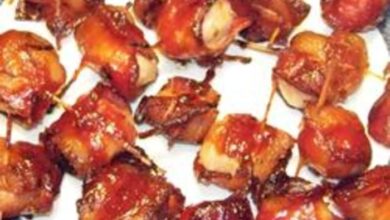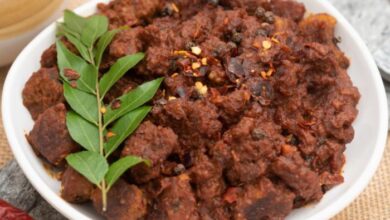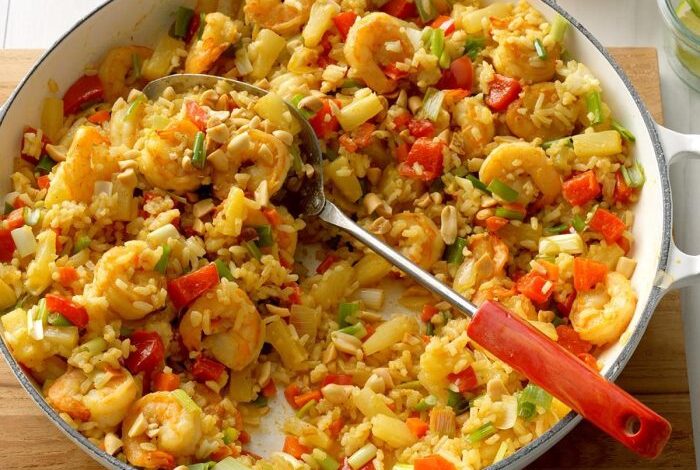
Pineapple Shrimp Fried Rice: A Delicious Fusion of Flavors
Pineapple shrimp fried rice takes center stage, a dish that tantalizes taste buds with its vibrant mix of sweet, savory, and spicy notes. This culinary masterpiece, born from a fusion of Asian flavors, offers a symphony of textures and aromas that transport you to bustling street food markets and elegant dining halls alike.
Imagine tender shrimp nestled amongst fluffy rice, all kissed by a sweet and tangy pineapple sauce. The addition of crunchy vegetables, aromatic herbs, and a hint of chili adds depth and complexity to each bite. Pineapple shrimp fried rice is a dish that speaks to the heart of culinary artistry, where simplicity meets sophistication, and every ingredient plays its part in creating a harmonious whole.
Pineapple Shrimp Fried Rice
Pineapple shrimp fried rice is a popular dish that combines the sweetness of pineapple with the savory flavors of shrimp and rice. Its origins are somewhat debated, but it’s widely believed to have emerged from the fusion of Chinese and Southeast Asian culinary traditions.This dish is a testament to the creativity of culinary innovation, where diverse flavors and ingredients come together to create a harmonious and delightful experience.
Cultural Significance
Pineapple shrimp fried rice holds a special place in various cultures, reflecting the influence of Chinese cuisine and the adaptability of culinary traditions.* Southeast Asia:In Thailand, a version of this dish called “Khao Pad Sapparot” is a beloved street food, often served with a spicy chili sauce.
China
While the exact origins are unclear, pineapple shrimp fried rice is a popular dish in many Chinese restaurants, showcasing the use of fresh ingredients and flavorful sauces.
Western Cultures
Pineapple shrimp fried rice has gained popularity in Western countries, often served as a main course or as a side dish in restaurants and homes.
Flavor Profile and Ingredients
The unique flavor profile of pineapple shrimp fried rice stems from the combination of sweet, savory, and slightly tangy ingredients. * Pineapple:The sweetness of the pineapple adds a distinct tropical touch, balancing the savory flavors of the other ingredients.
Shrimp
The shrimp provides a delicate, briny flavor that complements the rice and pineapple.
Rice
The rice serves as a base for the dish, absorbing the flavors of the other ingredients.
Vegetables
Pineapple shrimp fried rice is a dish that always reminds me of summer vacations, with its bright flavors and satisfying textures. It’s a great option for a quick and easy meal, but sometimes I crave something a bit more comforting and hearty.
That’s when I turn to a classic like gnocchi with pomodoro sauce , which offers a warm and satisfying experience. However, when I’m looking for a vibrant and light meal, pineapple shrimp fried rice always wins me over with its sweet and savory notes.
Common vegetables include onions, carrots, and peas, which add texture and a variety of flavors.
Soy Sauce
The soy sauce adds a savory and salty flavor, enhancing the overall taste of the dish.
Other Ingredients
Pineapple shrimp fried rice is a delicious and easy meal that’s perfect for a weeknight dinner. The sweet and savory flavors of the pineapple and shrimp are perfectly balanced by the fluffy rice and crunchy vegetables. If you’re looking for a hearty and satisfying soup to pair with your fried rice, I highly recommend checking out Chad’s slow cooker taco soup, which is a real crowd-pleaser.
It’s packed with flavor and perfect for a chilly evening. After all, a little bit of spice and heat can really complement the sweetness of the pineapple shrimp fried rice.
Other ingredients may include garlic, ginger, chili peppers, and egg, which contribute to the complexity and depth of flavor.
Pineapple shrimp fried rice is a dish that celebrates the fusion of flavors and cultures, offering a delightful and satisfying culinary experience.
Ingredients and Preparation
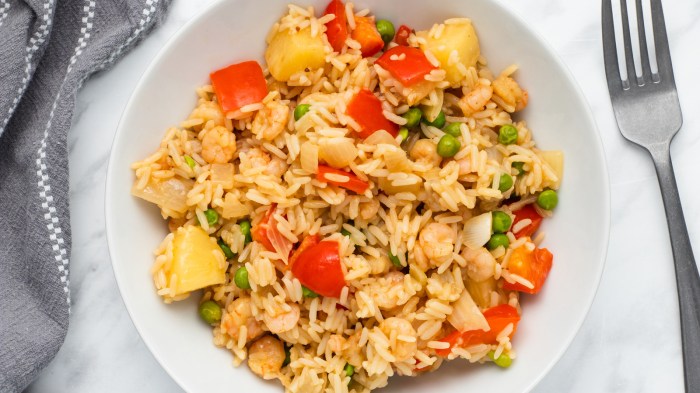
A delectable pineapple shrimp fried rice is a symphony of flavors and textures, and the secret lies in the quality of the ingredients and the meticulous preparation. Using fresh, high-quality ingredients is paramount to creating a truly memorable dish.
Essential Ingredients
The foundation of a classic pineapple shrimp fried rice recipe lies in the essential ingredients that contribute to its unique taste and aroma.
- Rice:Jasmine rice, known for its fragrant aroma and fluffy texture, is the ideal choice for this dish. Long-grain rice can be used as a substitute if jasmine rice is unavailable.
- Shrimp:Fresh, peeled, and deveined shrimp adds a delicate sweetness and a delightful chewiness to the dish. For a more intense flavor, try using larger shrimp.
- Pineapple:Fresh pineapple chunks provide a tangy sweetness and a vibrant color to the dish. Canned pineapple can be used as a substitute, but fresh pineapple is preferred for its superior flavor and texture.
- Vegetables:A medley of vegetables like onions, carrots, peas, and bell peppers adds texture and nutritional value to the dish. Other vegetables such as snow peas, bean sprouts, or water chestnuts can be added for variety.
- Eggs:Scrambled eggs add a rich, creamy texture and a subtle savory flavor to the dish.
- Soy Sauce:Soy sauce provides a salty umami flavor that balances the sweetness of the pineapple and the shrimp. Low-sodium soy sauce can be used as a substitute for those who are watching their sodium intake.
- Oyster Sauce:Oyster sauce adds a savory depth of flavor and a hint of sweetness to the dish. If oyster sauce is unavailable, a combination of soy sauce and fish sauce can be used as a substitute.
- Garlic and Ginger:Freshly minced garlic and ginger add a pungent and aromatic flavor to the dish. For a milder flavor, use a garlic paste or powdered ginger.
- Sesame Oil:Sesame oil adds a nutty flavor and a pleasant aroma to the dish. Other neutral cooking oils like vegetable oil or canola oil can be used as a substitute.
Ingredient Variations and Substitutions
For those with dietary restrictions or preferences, variations and substitutions can be made to the recipe.
Pineapple shrimp fried rice is one of those dishes that always feels like a celebration. The sweet and savory flavors are so satisfying, and the crunchy bits of rice add a fun textural element. But sometimes, you want something a little lighter and more refreshing.
That’s where dessert comes in! I love pairing my pineapple shrimp fried rice with a slice of Sybil’s Old Fashioned Lemon Layer Cake , which has a bright, tangy flavor that cuts through the richness of the fried rice. It’s the perfect way to end a meal on a high note!
- Gluten-Free:Use tamari or gluten-free soy sauce instead of regular soy sauce.
- Vegetarian:Replace the shrimp with tofu or tempeh for a meat-free version. Use vegetable broth instead of oyster sauce.
- Vegan:Use a vegan substitute for eggs, such as a flaxseed egg or silken tofu. Use vegetable broth instead of oyster sauce.
- Low-Sodium:Use low-sodium soy sauce and oyster sauce. Reduce the amount of salt added to the dish.
- Spicy:Add a pinch of red pepper flakes or chili paste to the dish for a spicy kick.
Preparing the Rice
The foundation of a great pineapple shrimp fried rice is perfectly cooked rice.
- Cook the rice:Rinse the rice thoroughly in a fine-mesh strainer until the water runs clear. Combine the rice with water in a saucepan, following the package instructions for cooking time. Once the rice is cooked, fluff it with a fork and let it cool slightly.
- Season the rice:While the rice is cooling, add a tablespoon of soy sauce and a pinch of sesame oil to the rice and stir gently to distribute the flavors.
Preparing the Shrimp
Shrimp adds a delightful sweetness and a delightful chewiness to the dish.
- Prepare the shrimp:Peel and devein the shrimp. Marinate the shrimp in a mixture of soy sauce, sesame oil, and a pinch of black pepper for about 15 minutes. This helps to enhance the flavor of the shrimp and adds a subtle salty and savory note.
- Cook the shrimp:Heat a tablespoon of oil in a wok or large skillet over medium-high heat. Add the marinated shrimp and cook until pink and opaque, about 2-3 minutes per side. Remove the shrimp from the pan and set aside.
Preparing the Vegetables
A medley of fresh vegetables adds texture and nutritional value to the dish.
- Prepare the vegetables:Chop the vegetables into bite-sized pieces. For example, dice the onions, carrots, and bell peppers, and cut the peas and snow peas into smaller pieces. This ensures that the vegetables cook evenly and retain their vibrant colors and flavors.
- Cook the vegetables:Add the chopped vegetables to the wok or skillet with a tablespoon of oil and cook until tender-crisp, about 3-5 minutes. Season the vegetables with salt and pepper to taste.
Using Fresh, High-Quality Ingredients
The quality of the ingredients is paramount to creating a truly memorable pineapple shrimp fried rice. Using fresh, high-quality ingredients ensures a brighter flavor, a more vibrant color, and a superior texture.
“Fresh ingredients are the key to a delicious pineapple shrimp fried rice. Using fresh, high-quality ingredients ensures a brighter flavor, a more vibrant color, and a superior texture.”
Cooking Techniques and Tips
Mastering the art of pineapple shrimp fried rice involves a few key techniques and tips that will elevate your dish from ordinary to extraordinary. From ensuring the perfect texture to achieving a vibrant flavor profile, these guidelines will help you create a culinary masterpiece.
Cooking Shrimp Properly
Cooking shrimp to perfection is crucial for a delicious and satisfying pineapple shrimp fried rice. Overcooked shrimp becomes tough and rubbery, while undercooked shrimp poses a food safety risk. Here’s how to ensure your shrimp is cooked just right:
- Start with fresh shrimp:Fresh shrimp will have a translucent appearance and a mild, sweet aroma. Avoid shrimp that has a strong fishy odor or appears discolored.
- Pat dry the shrimp:Excess moisture can lead to steaming rather than searing, resulting in a less flavorful shrimp. Pat the shrimp dry with paper towels before cooking.
- Use high heat:A hot pan or wok allows the shrimp to sear quickly, creating a beautiful crust while retaining its juicy interior. Aim for a pan temperature of around 375°F (190°C).
- Cook shrimp for a short time:Shrimp cooks quickly, typically 1-2 minutes per side. Overcooking will result in tough, rubbery shrimp. To determine if the shrimp is cooked, look for a color change from translucent to opaque. The shrimp should also be firm to the touch.
- Remove shrimp from heat:Once cooked, immediately remove the shrimp from the heat to prevent overcooking. Transfer the shrimp to a plate or bowl and set aside.
Using a Wok or Large Skillet
A wok is the traditional vessel for preparing fried rice, but a large skillet can also be used. The wide base of a wok allows for even heat distribution and facilitates quick cooking. Here’s how to utilize a wok or skillet effectively:
- Heat the wok or skillet thoroughly:Before adding any ingredients, heat the wok or skillet over high heat for about 2-3 minutes. This will ensure that the ingredients cook quickly and evenly.
- Add oil to the wok or skillet:Use a neutral oil with a high smoke point, such as vegetable oil or peanut oil. Add enough oil to coat the bottom of the wok or skillet, about 1-2 tablespoons.
- Stir-fry ingredients:Stir-fry the ingredients quickly and constantly to prevent sticking and ensure even cooking. Use a spatula or wooden spoon to toss the ingredients.
- Don’t overcrowd the wok or skillet:Overcrowding the wok or skillet will lower the temperature and result in steaming rather than stir-frying. If necessary, cook the ingredients in batches.
Achieving the Perfect Texture and Flavor
The key to perfect pineapple shrimp fried rice lies in achieving the right texture and flavor. Here are some tips to help you create a truly delicious dish:
- Use day-old rice:Day-old rice is slightly dried out, which prevents it from becoming mushy when stir-fried. If using freshly cooked rice, let it cool completely and spread it out on a baking sheet to dry for 30 minutes.
- Season generously:Use a combination of soy sauce, fish sauce, oyster sauce, and sugar to create a flavorful base. Don’t be afraid to season generously, as the flavors will meld together during cooking.
- Add aromatics:Enhance the flavor of your fried rice by adding aromatics such as garlic, ginger, and scallions. Stir-fry them briefly before adding the rice.
- Don’t overcook the rice:Overcooked rice will become mushy and lose its texture. Stir-fry the rice for just a few minutes, until it is heated through and slightly crispy.
- Incorporate pineapple:Use fresh pineapple chunks or diced canned pineapple. The sweetness of the pineapple will complement the savory flavors of the shrimp and rice.
Flavor Variations and Enhancements
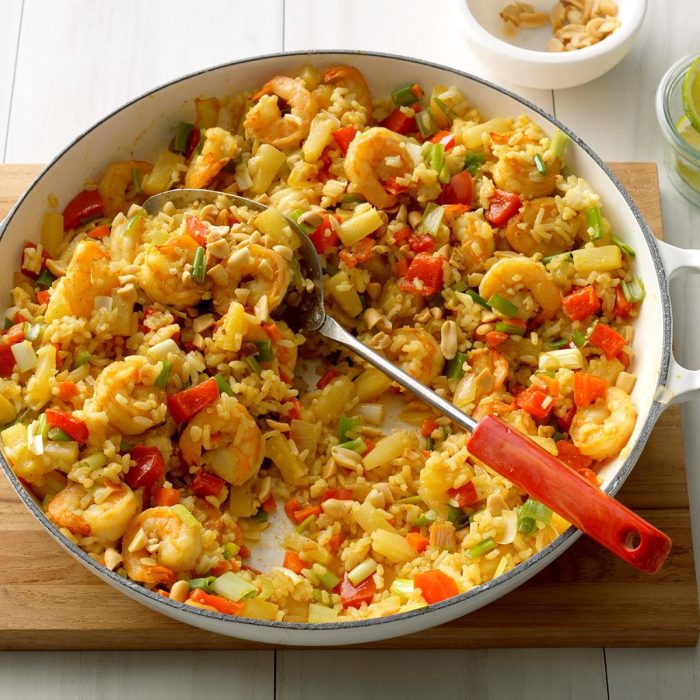
Pineapple shrimp fried rice is a delicious and versatile dish that can be customized to suit your taste buds. While the classic recipe is already flavorful, there are many ways to enhance the flavor profile and create a truly unique culinary experience.
Sauce and Seasoning Options
Different sauces and seasonings can significantly impact the flavor of your pineapple shrimp fried rice. Here are some ideas:
- Soy Sauce:A staple in Asian cuisine, soy sauce adds a savory and umami flavor to the dish. You can use regular soy sauce or a low-sodium variety for a lighter flavor.
- Oyster Sauce:Oyster sauce brings a rich and savory flavor to the dish, adding a touch of sweetness and depth.
- Fish Sauce:Fish sauce is a fermented condiment that adds a salty and pungent flavor to the dish. It is often used in Thai and Vietnamese cuisine.
- Sriracha Sauce:Sriracha sauce provides a spicy kick to the dish, adding a touch of heat and complexity.
- Sesame Oil:Sesame oil adds a nutty and fragrant aroma to the dish. Use a high-quality sesame oil for the best results.
The Role of Herbs and Spices
Fresh herbs and spices play a crucial role in creating a vibrant and aromatic dish.
- Cilantro:Cilantro adds a fresh and herbaceous flavor to the dish.
- Mint:Mint adds a cool and refreshing flavor to the dish, balancing the richness of the shrimp and pineapple.
- Basil:Basil adds a sweet and peppery flavor to the dish, complementing the other ingredients.
- Ginger:Ginger adds a warm and spicy flavor to the dish, balancing the sweetness of the pineapple.
- Garlic:Garlic adds a pungent and savory flavor to the dish, enhancing the overall flavor profile.
Creative Additions
To add an extra layer of flavor and texture, consider incorporating creative additions like nuts, dried fruits, or different vegetables.
- Nuts:Toasted almonds, cashews, or peanuts add a crunchy texture and nutty flavor to the dish.
- Dried Fruits:Raisins, cranberries, or chopped dates add a touch of sweetness and chewy texture.
- Vegetables:Add chopped bell peppers, carrots, or snow peas for extra flavor and nutrients.
Adjusting the Spice Level
To suit individual preferences, you can easily adjust the spice level of your pineapple shrimp fried rice.
- For a milder dish:Use less chili flakes or omit them entirely.
- For a spicier dish:Add more chili flakes or use a hotter chili paste.
Serving Suggestions and Accompaniments
Pineapple shrimp fried rice is a dish that can be enjoyed hot and fresh, making it a perfect choice for a satisfying meal. The ideal serving temperature allows the flavors to fully bloom and the rice to maintain its texture.
Here are some suggestions for serving this delicious dish and enhancing the overall dining experience.
Serving Temperature
The ideal serving temperature for pineapple shrimp fried rice is hot, right after it’s cooked. The heat helps to amplify the flavors and keeps the rice from becoming dry or sticky. A good rule of thumb is to serve the fried rice as soon as it’s cooked, while the ingredients are still warm and the rice is fluffy.
Accompaniments, Pineapple shrimp fried rice
Accompaniments can elevate the dining experience by adding contrasting flavors and textures to the fried rice. Here are some suitable options:
Side Salad
A light and refreshing side salad can provide a nice balance to the richness of the fried rice. Consider a simple green salad with a vinaigrette dressing or a more complex salad with grilled chicken or tofu.
Soup
A light soup, such as a clear broth or a vegetable soup, can be a comforting accompaniment to the fried rice. The soup can help to cleanse the palate between bites and add another dimension of flavor to the meal.
Dipping Sauce
A dipping sauce can add an extra layer of flavor to the fried rice. Consider a sweet and sour sauce, a chili sauce, or a soy sauce-based dipping sauce.
Cultural Context
Pineapple shrimp fried rice is a popular dish in many cultures around the world. In Southeast Asia, it is often served with a side of chili sauce or a dipping sauce. In the United States, it is often served with a side salad or a soup.
Presentation
Presentation plays a key role in making a dish visually appealing and enticing. Here are some suggestions for presenting pineapple shrimp fried rice in an attractive and appetizing manner:
Serving Bowl
Serve the fried rice in a large, shallow bowl to allow for even distribution of the ingredients and a visually appealing presentation.
Garnish
Garnish the fried rice with fresh cilantro, chopped green onions, or toasted sesame seeds.
Color Contrast
Use contrasting colors to create a visually appealing presentation. For example, you could use a red chili pepper or a sprig of green cilantro to add pops of color to the dish.
Health and Nutritional Considerations
Pineapple shrimp fried rice is a delicious and popular dish, but it’s important to consider its nutritional value and how it fits into a balanced diet. While it can be a tasty and satisfying meal, it’s also crucial to be mindful of its potential downsides and make informed choices to enjoy it responsibly.
Nutritional Value
Pineapple shrimp fried rice offers a blend of carbohydrates, protein, and some vitamins and minerals. The rice provides carbohydrates for energy, while shrimp is a good source of protein, which is essential for muscle growth and repair. Pineapple contributes fiber, vitamin C, and manganese, which are important for digestion, immunity, and bone health.
However, the dish can also be high in sodium and fat, depending on the cooking methods and ingredients used.
Benefits of Shrimp and Pineapple
Shrimp is a lean protein source, low in calories and fat, and rich in essential nutrients like omega-3 fatty acids, vitamin D, and selenium. These nutrients contribute to heart health, immune function, and cognitive function. Pineapple, a tropical fruit, is packed with vitamin C, an antioxidant that supports immune health and collagen production.
Its bromelain enzyme may aid digestion and reduce inflammation.
Tips for Making This Dish Healthier
- Use brown rice instead of white rice:Brown rice is a whole grain, which means it contains more fiber and nutrients than white rice. It’s also lower on the glycemic index, which means it won’t cause blood sugar spikes.
- Reduce the amount of oil used:Fried rice can be high in fat if too much oil is used. Try using a non-stick pan and a light cooking spray instead of oil.
- Add more vegetables:Vegetables like broccoli, carrots, and peas are low in calories and high in vitamins and minerals. They can add flavor and nutrients to your fried rice.
- Use less sodium:Many fried rice recipes call for soy sauce, which can be high in sodium. Use a low-sodium soy sauce or try other alternatives like tamari or coconut aminos.
Potential Allergens and Dietary Restrictions
- Shellfish allergy:Shrimp is a common allergen, so individuals with shellfish allergies should avoid this dish.
- Gluten intolerance or celiac disease:Some fried rice recipes may contain soy sauce or other ingredients that contain gluten. Look for gluten-free soy sauce or other alternatives to make this dish suitable for those with gluten sensitivities.
- Dairy allergy:Some fried rice recipes may include dairy products like milk or cheese. If you have a dairy allergy, be sure to check the ingredients list and avoid dishes that contain dairy.

